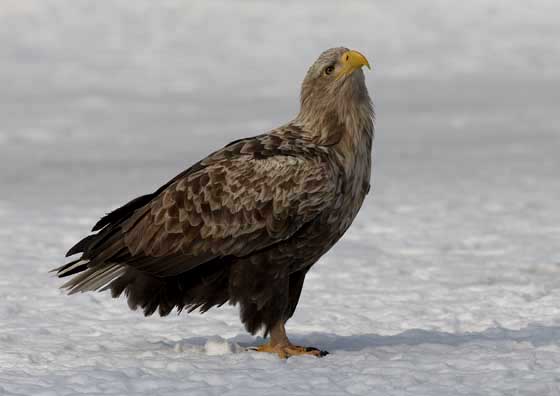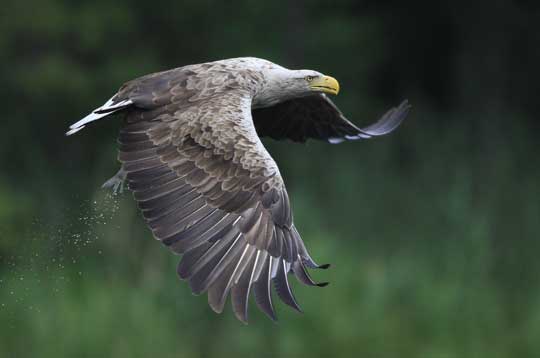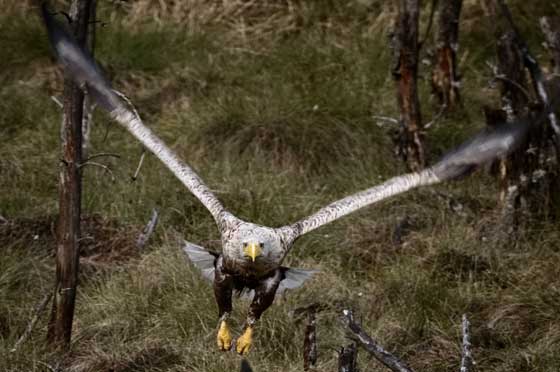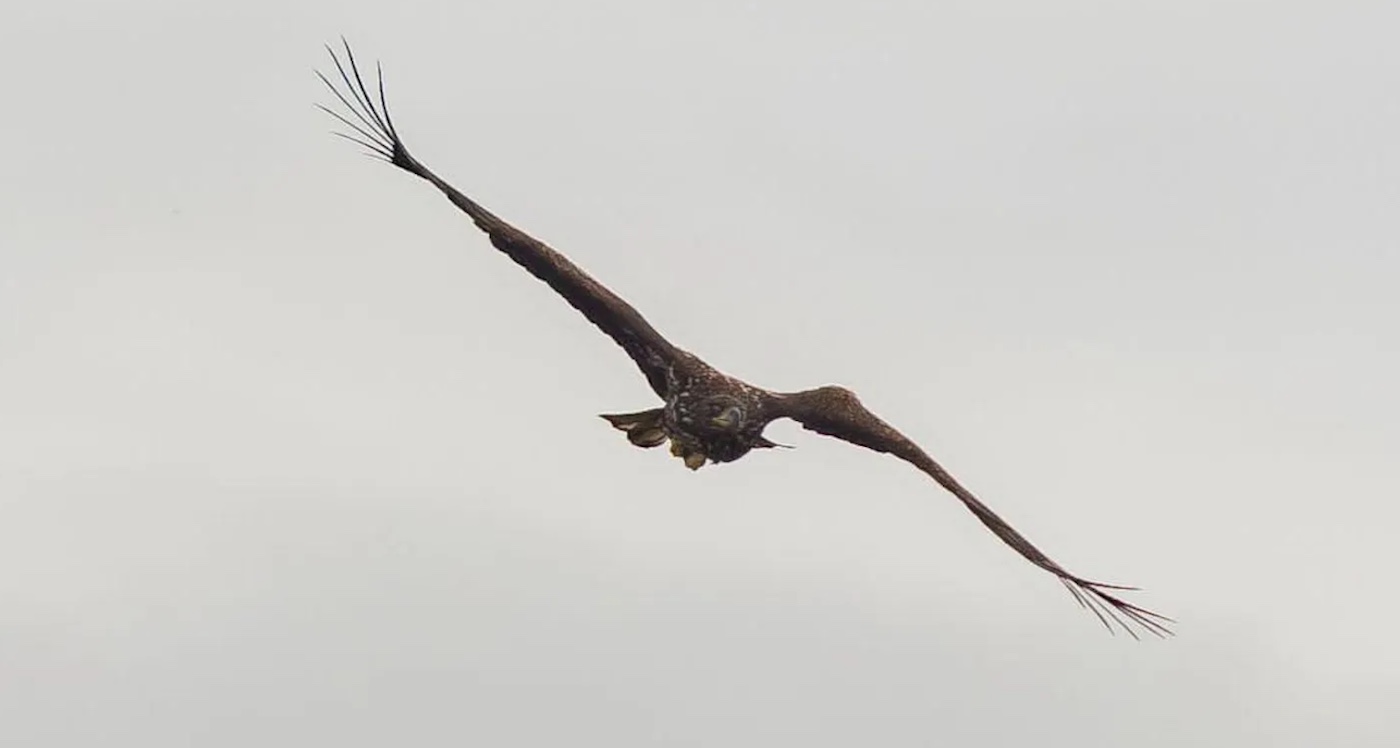In many ways, we are living in a remarkable age of progress for nature conservation. Raptors driven to extinction in Britain long ago by Man’s ignorance and intolerance are being brought back into our modern word by a welcome programme of reintroduction, turning what was once considered to be an impossible dream into a reality and bringing enjoyment and pleasure to our more enlightened society. The White-tailed Eagle is the only remaining raptor extirpated from England as a breeding bird which has yet to be returned.
Adult Male White-tailed Eagle – Standing at 900mm high with a wing span of 2.5m or more.
Copy Right Image Terry Pickford
In January 2006, English Nature (Natural England) published detailed proposals for the reintroduction of up the 80 White-tailed Eagle chicks into East Anglia over a period of four years. Plans were already well advanced to bring the first batch of eaglets from Poland‘s Sierakow Forest where numbers of pairs have increased dramatically in the last decade. However following extensive opposition from the local community Natural England instead announced that because of financial cut backs plans to bring back White-tailed Eagles to Suffolk were being placed on indefinite hold. The RSPB although disappointed at the cancellation of the Suffolk project have insisted it remains committed to returning White-tailed Eagles back to England and will begin to investigate other methods of funding a reintroduction scheme, including looking at a number of other release locations in England. Let us all hope that the sensible option of Cumbria is top of the RSPB list!
Adult Male White-tailed Eagle -Fishing.
Copy Right Image Terry Pickford
There can now be little doubt White-tailed Eagles since their initial introduction north of the border are bringing unforeseen economic growth and renewed prosperity to parts of rural Scotland. Increasing numbers of birdwatchers are now visiting the highlands and islands each year just to see and study this magnificent avian predator, bringing “tourist dollars” to the small rural communities where they stay. A study on the island of Mull in 2005 established that eagle-related ecotourism was contributing £1.5 million pounds per annum to the local economy. This financial benefit is now estimated to be at least double the previous figure. Undoubtedly, the growing interest in the species focuses attention on the importance of its continued survival to the prosperity of those isolated communities where it occurs.
Mixed Fortunes in Europe
The White-tailed Eagle is one of Europe’s largest and most majestic birds of prey, second perhaps to the larger Lammergeyer found in the French Alps, Austria and now Switzerland. A mature female White-tailed Eagle can weight almost 6 kilos. The adult is recognised by its striking pure white tail, immense yellow bill, yellow scaly legs and yellow iris. The head and neck are much paler than the rest of the brown body; the wings are dark brown and much broader than those of a Golden Eagle. White-tailed Eagles take five or six years to reach breeding maturity and can live to an age of 25 or even 30 years. It seems conceivable that the species can breed to an age of 25 years or even longer.
Adult Male White-tailed Eaglewith small chick – 25m above the ground.
Copy Right Image Terry Pickford
The largest White-tailed Eagle eyrie on record was discovered in Poland. Occupied by the same breeding pair for more than 20 years, this huge construction was positioned 27 meters above the ground at the top of a mature Scots Pine. The longest-tenanted European White-tailed Eagle’s nest – the remains of which could still be observed several years ago on Wolin Island along the Baltic coast – was in use for 70 consecutive seasons. The White-tailed Eagle (or Bielik) is Poland’s national emblem. The Polish population has never been at risk of extinction, thanks to strong historic wildlife legislation dating back as far as 1921. Poland’s White-tailed Eagles have therefore been spared the systematic persecution that occurred throughout the 19th and 20th centuries in Scotland and many other European countries.
From just 30 pairs in 1945, numbers have now increased toover 1000pairs in Poland. Currently this is the largest population in Central Europe and the Baltic area, and it represents more than 5-7 per cent of the world population. Of the 333 territories examined in Poland in 2000, 198 eyries produced a staggering 287 fledged young. In 2005, of the 80 White-tailed Eagle territories studied throughout the Sierakow Forest and surrounding forest regions, 65 per cent of nests successfully produced young. Of the 39 eaglets ringed in the Sierakow Forest in 2005, four nests contained a single eaglet, 13 held two and a further three eyries produced triplets. The high incidence of triplets in Poland is thought to occurs due to an abundance of prey throughout the whole year in most nesting territories.
Adult Male White-tailed Eagle.
Copy Right Image Terry Pickford
As the number of pairs of White-tailed Eagles in Poland continues to increase each year, the birds’ territories are shrinking. In one relatively small area of forest of just 1,300 ha, Polish scientists located seven breeding pairs; a density of one pair per 186 ha. Moreover, habitat choices are changing. Until the 1970-s Polish eyries were located almost exclusively in extensive mature pine forests (70-80 years old), but an increasing number of pairs have since begun to choose smaller forests, constructing their nests in woodlands as small as 10 ha, often on sites surrounded by extensive fields used for agriculture.
A personal dream comes true.
My obsessive passion for eagles began when I was a small boy living in the Derbyshire Peak District sixty years ago, but it was not until 1962, when I was 18, that I saw my first Golden Eagle while working as a unpaid RSPB volunteer on Speyside. It was while watching golden eagles amongst the ancient pines of the Abernethy Forest I first met and talked to a one of the Highland’s foremost Golden Eagle legends the late, but never forgotten Seaton Gordon. It was another 22 years, and a photography trip to Skye, for me to connect with the larger White-tailed Eagle. That single observation made from Peter Urquart’s small fishing boat inspired me to seek out this elusive raptor in Poland, a part of Europe that until relatively recently was off-limits to western visitors, behind the iron Curtain.
Sub Adult over frozenlake
Copy Right Image Terry Pickford
Through the efforts of raptor conservation friends in the Czech Republic, a country I had first visited in 1967, it was arranged via their Polish contacts to introduce me to Professor Mizera, a leading Polish White-tailed Eagle expert. In September 2002 I received an official invitation from Poland’s Eagle Protection Committee to visit the Sierakow Forest, a White-tailed Eagle hot spot, to pursue my insatiable interests in raptors. Having obtained approval to photograph White-tailed Eagles within a number of the public exclusion zones that encircle all the nesting trees throughout the country, I was hopeful that I could now obtain the images I required within a matter of a few months – or so I thought. What I hadn’t fully appreciated was that although I was one of a small number of approved licence recipients, my project would take the best part of seven years to complete.
The Dream Begins.
During the first few days exploring the Sierakow Forest in the golden autumn of 2002, I was guided by an enthusiastic Prof. Mizera along seemingly endless forest paths, covered by a soft carpet of lichen and bilberry. The chilly seasonal dampness was already beginning to transform the surrounding forest canopy into a rich multitude of spectacular colours. The pungent aroma of fungi completely filling the still, moist air as we walked through the eagles’ serene forest kingdom. Each eyrie I was shown measured about 2 metres across and had been constructed at the top of a very mature Scots Pine. The remains of dead fish and a profusion of discarded feathers and white droppings were clearly visible, scattered in a wide arc around the base of each nesting tree we inspected. At one point I heard the yelp of an eaglet from not too far away-at least one fledgling was still within the territory so late in the year. In the presence of an Avian dinosaurs Over the next 7 years, I spent many hours photographing White-tailed Eagles at and near the nest, and enjoyed many priceless encounters with these incredible birds throughout each season of the year.
Could this bethe view future visitors to Windermere may behold one day?
Copy Right Image Terry Pickford
On one memorable occasion, I was sitting in my hide when I suddenly became aware that the eagle I had been admiring through my lens at the far side of the woodland fire-break was now flying towards my elevated position, almost 9 metres above the forest floor. With no time to think or focus my lens, I managed to expose two frames before the huge shape resembling a winged dinosaur vanished with deafening wing-beats over my head, alighting with a heavy thud on top of my hide. For the next few seconds I was spellbound, hardly able to move a muscle as the huge eagle walked on top of the hide, just centimetres above my head. When it stopped moving the silence all around me was profound-the only sounds I could hear were my breathing and the pounding of my heart. After a few moments, I gained enough courage to place my eye to a small hole in the wooden roof above me, and for an amazing moment I was eyeball to eyeball with an adult White-tailed Eagle. I don’t know who was more surprised, the eagle or me. The bird did not wait around, taking flight into the depths of the forest just as quickly as it had appeared.
The split second before thisEagle landed on top of my hide.
Copy Right Image Terry Pickford
An unforgettable Experience
Throughout this thrilling project, I collected many extraordinary and stimulating memories of the beauty and rich diversity of Poland’s state forests, and enjoyed the first-hand observations of fauna and flora that in many cases have already disappeared from large areas of other over-developed countries. These experiences, together with the kindness and hospitality I was shown by my host, will remain with me for the rest of my life. The following statement was made in 2004 by the General Director of Poland’s State Forests, in celebration of 80 years’ management of resources by the “State Forests” National Forest Holdings:
“Our forests are exceptional in Europe, not only due to their natural character, but mainly because of their common accessibility. It enables us, as foresters, to treat the Polish forests as a great gift for Europe, especially in the year of Poland’s accession to the European Community. For 80 years the State Forests have been treating these habitats as a natural wealth, an integral and common good belonging to every citizen. Let it remain this way. “
I am confident that the hundreds of hours spent sitting in cramped hides at temperatures lower than -15 C to obtain the images used to illustrate this story have been hours well spent. I hope you will agree that the return of the White-tailed Eagle into the English Landscape will provide a legacy we can all appreciate and enjoy in the years to come.
Terry R.Pickford
North West Raptor Group
www.raptorpolitics.org.uk
Terry Pickford
Throughout the last 47 years I have been involved in the conservation and protection of some of England’s rarest birds of prey. In 1967, in joint cooperation with the RSPB, the Nature Conservancy, now English Nature, I became a founder member of England’s first Raptor Study and Protection Group (The North West Raptor Group). Since 1974 my field work with raptors has been licensed by English Nature. I was a member of the UK Government Raptor Working Group which sat from 1995 to 2000. I am a qualified BTO licensed ‘A’ ringer permitting me to ring a variety of protected birds of prey at their nesting sites, including Golden Eagle (Scotland), Osprey, Red Kite, Goshawk, Peregrine Falcon and Barn Owl (England.) Between the years 1966 - 1976 I worked primarily throughout Speyside under the direction of the Hon. Douglas Weir (RSPB) where my work involved monitoring both the Golden Eagle and Peregrine Falcon populations in the Speyside area. In 1977 my work returned to England, where I began to monitor Peregrine nesting activity in both the Lake District National Park and the Forest of Bowland in Lancashire. During the past 40 years my activities associated with the peregrine falcon have been featured in several television documentaries. In 1986 my conservation work was featured in Central Televisions’ Nature Watch series hosted by Julian Petiffer. In the early 1980’s I was also involved in the reintroduction of the Peregrine Falcon (taken under licence from Scotland by a member of SNH), together with other falcons propagated in captivity back into the natural environment inside the Czech Republic, subsequently bringing about the recolonisation of peregrines in that country. In 1999 I decided to concentrate full time presenting wildlife illustrated lectures dealing specifically with raptors, their environment and protection. In 2002 at the invitation of the Polish Sea Eagle Conservation Committee, I became one of only a small handful of photographers permitted to photograph the White-tailed Sea Eagle inside Poland’s Sierakow Forest where I had been issued with the appropriate licence. The project lasted for 7 years until 2008. In the summers of 2011 and 2012 I returned to Scotland where I worked under a Scientific licence issued by Scottish Natural Heritage and the BTO to monitor and ring Golden Eagle in the Highland region. Most of this field work has been concentrated in the Blackmount and Glen Coe areas.







Leave a Reply